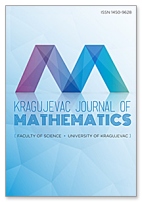Bell Graphs are Determined by their Laplacian Spectra
 Download PDF
Download PDF
Authors: A. Z. ABDIAN
DOI: 10.46793/KgJMat2302.203A
Abstract:
A graph G is said to be determined by the spectrum of its Laplacian spectrum (DLS, for short) if every graph with the same spectrum is isomorphic to G. An ∞-graph is a graph consisting of two cycles with just a vertex in common. Consider the coalescence of an ∞-graph and the star graph K1,s, with respect to their unique maximum degree. We call this a bell graph. In this paper, we aim to prove that all bell graphs are DLS.
Keywords:
Bell graph, Laplacian spectrum, L-cospectral, cospectral graphs, spectral characterization.
References:
[1] W. N. Anderson and T. D. Morley, Eigenvalues of the Laplacian of a graph, Linear Multilinear Algebra 18 (1985), 141–145. https://doi.org/10.1080/03081088508817681
[2] D. M. Cvetković, P. Rowlinson and S. K. Simić, Signless Laplacian of finite graphs, Linear Algebra Appl. 423 (2007), 155–171. https://doi.org/10.1016/j.laa.2007.01.009
[3] D. M. Cvetković, P. Rowlinson and S. K. Simić, An Introduction to the Theory of Graph Spectra, London Mathematical Society Student Texts 75, Cambridge Univ. Press, Cambridge, 2010.
[4] K. Ch. Das, On conjectures involving second largest signless Laplacian eigenvalue of graphs, Linear Algebra Appl. 432 (2010), 3018–3029. https://doi.org/10.1016/j.laa.2010.01.005
[5] L. Feng and G. Yu, No starlike trees are Laplacian cospectral, Publikacije Elektrotehničkog fakulteta. Serija Matematika 18 (2007), 46–51. https://doi.org/10.2298/PETF0718046F
[6] R. Grone and R. Merris, The Laplacian spectrum of graph II, SIAM J. Discrete Math. 7 (1994), 221–229.
[7] A. K. Kelmans, The number of trees in a graph I, II, Automat, Remote Control 26 (1965), 2118–2129 and 27 (1966), 233–241 (Translated from Avtomat. i Telemekh. 26 (1965), 2118–2129 and 27 (1966), 233–241 [in Russian]).
[8] J. S. Li and Y. L. Pan, A note on the second largest eigenvalue of the Laplacian matrix of a graph, Linear and Multilinear Algebra 48 (2000), 117–121. https://doi.org/10.1080/03081080008818663
[9] F. J. Liu and Q. X. Huang, Laplacian spectral characterization of 3-rose graphs, Linear Algebra Appl. 439 (2013), 2914–2920. https://doi.org/10.1016/j.laa.2013.07.029
[10] X. Liu, Y. Zhang and X. Gui, The multi-fan graphs are determined by their Laplacian spectra, Discrete Math. 308 (2008), 4267–4271. https://doi.org/10.1016/j.disc.2007.08.002
[11] C. S. Oliveira, N. M. M. de. Abreu and S. Jurkiewilz, The characteristic polynomial of the Laplacian of graphs in (a,b)-linear cases, Linear Algebra Appl. 356 (2002), 113–121. https://doi.org/10.1016/S0024-3795(02)00357-9
[12] E. R. van Dam and W. H. Haemers, Which graphs are determined by their spectrum?, Linear Algebra Appl. 373 (2003), 241–272. https://doi.org/10.1016/S0024-3795(03)00483-X
[13] F. Wen, Q. Huang, X. Huang and F. Liu, The spectral characterization of wind-wheel graphs, Indian J. Pure Appl. Math. 46 (2015), 613–631. https://doi.org/10.1007/s13226-015-0141-8
[14] J. Wang, Q. Huang, F. Belardo and E. M. Li Marzi, On the spectral characterizations of ∞-graphs, Discrete Math. 310 (2010), 1845–1855. https://doi.org/10.1016/j.disc.2010.01.021
[15] J. Wang, Q. Huang and F. Belardo, On the spectral characterizations of 3-rose graphs, Util. Math. 91 (2013), 33–46.
